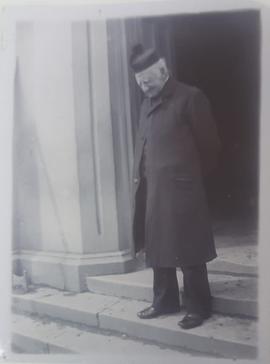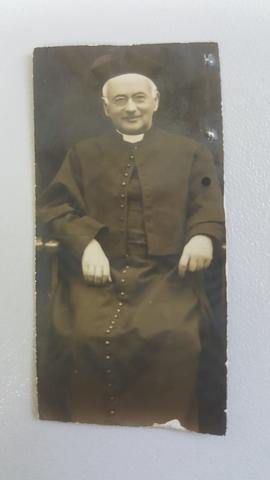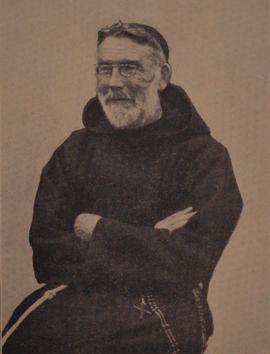Thomas Morrissey was Provincial of the Irish Vincentian Province 1888-1909.
Joseph Walshe was Provincial of the Irish Vincentian Province 1909-1921.
John Mary Harty was born in Murroe, County Limerick in 1867. He received his education at Jesuit College, Limerick, Saint Patrick's College, Thurles, and Maynooth. He entered First Philosophy on 1 September 1887 and was ordained priest on 20 May 1894 in Clonliffe College, Dublin, by Dr. William Walsh of Dublin. The next year, after a competitive examination, he was appointed to the Chair of Dogmatic Theology in Maynooth, the year after ordination being spent in postgraduate study in Dunboyne.
He published treatises on Grace and on the Sacraments. Later he was appointed Senior Professor of Moral Theology and held this chair till his appointment as Archbishop on the resignation of Dr. Fennell. The voting of P.P.'s for new Bishop was Dr. Harty, Maynooth College - 20; Dr. John Slattery, Thurles College - 10; Rev. Tom F. Power P.P. V.F. Galbally - 8; Mgr. Riordan, Rector, Irish College, Rome - 2; Canon Arthur Ryan P.P. V.G. - 6. Tipperary - 1; Dr. Kelly, Bishop of Ross - 1.
Dr. Harty was appointed in November 1913 and consecrated in Thurles on 8 January 1914 by Archbishop Fennelly. After consecration the priests of the Archdiocese presented him with a motor car costing Ł500. His gentle manners and kindly disposition endeared him to all - both clergy and laity. For a number of years before his death, ill-health restricted his activities. He requested a Coadjutor from the Holy See, indicating that his wish was Dr. Jeremiah Kinnane, Bishop of Waterford since 1932, and a priest of the Archdiocese. In 1942, the Holy See acceded to his wish and Dr. Kinnane resigned his see of Waterford and became Coadjutor Archbishop of Cashel and titular Archbishop of Dercos and Dean of Cashel Diocesan Chapter, with Cashel as his parish.
Totally confined to the Archbishop's Palace by progressive debility from this period till his death on 1 September 1946, Archbishop Harty died aged 79 years. He was for many years President of the Catholic Truth Society of Ireland (from 14 October1914) and Patron of G.A.A. from 1928.
Dr. Harty received letter of appointment as Archbishop on 2 December 1913, and Bulls of appointment on 8 December 1913. The Bulls stated that perpetual administration of the see of Emly is attached to the see of Cashel. Dr. Harty had Pallasgreen and Solohead as mensal parishes - latter permitted by Rome (January 1915) while Dr. Fennelly lived.
A native of Tarbert in County Kerry, Thomas O’Connor was born on 16 July 1859. At the age of seventeen, he joined the Capuchin Franciscans and took Matthew as his religious name. He was ordained a priest on 27 August 1882. He held several senior leadership positions in the Order in Ireland and was twice elected Provincial Minister (1893-6 and 1898-1901). He served as President of Father Mathew Memorial Hall on Church Street in Dublin from 1894 to 1895. Much of his later life in ministry was spent in Kilkenny and he died in the Capuchin Friary in the city on Sunday, 27 April 1930. He was buried in Foulkstown Cemetery just outside Kilkenny city.
Baptismal name: Thomas O’Connor
Religious name: Fr. Matthew O’Connor OFM Cap.
Date of birth: 16 July 1859
Place of birth: Tarbert, County Kerry
Name of father: John O’Connor
Name of mother: Ellen O’Connor (née Heagerty)
Date of reception into the Capuchin Order: 16 July 1876
Date of first profession: July 1877
Date of final profession: 4 Oct. 1880
Date of ordination (as priest): 27 Aug. 1882
Leadership positions: Provincial Minister: 1893-6, 1898-1901; Provincial Definitor (Councillor): 1885-8, 1887-90, 1890-3, 1905-8, 1910-3; Custos: 1887, 1890, 1895, 1901, 1907.
Date of death: 27 Apr. 1930
Place of death: Capuchin Friary, Kilkenny
Place of burial: Foulkstown Cemetery, County Kilkenny
Baptismal name: Edward Bowe
Religious name: Fr. Peter Bowe OFM Cap.
Date of birth: 19 Sept. 1856
Place of birth: Tullaroan, County Kilkenny
Name of father: Thomas Bowe (b. 3 Nov. 1816)
Name of mother: Ellen Bowe (née Maher) (b. 1815)
Date of reception into the Capuchin Order: 8 Apr. 1877
Date of first profession: 21 Apr. 1878
Date of final profession: 8 Sept. 1881
Date of ordination (as priest): 27 Aug. 1882
Leadership positions: Provincial Minister: 1901-4, 1907-10, 1916-9, 1922-5; Provincial Definitor (Councillor): 1887-90, 1890-3, 1893-6, 1895-8, 1898-1901, 1913-6; Custos: 1904, 1910, 1919, 1925
Date of death: 25 Nov. 1926
Place of death: Church Street Friary, Dublin
Place of burial: Glasnevin Cemetery, Dublin
Nicholas Phelan was born in Graiguenamanagh, a small town on the border between Counties Carlow and Kilkenny, on 16 June 1874. He joined the Capuchins at the age of sixteen, took Benedict as his religious name, and was professed in 1891. He was ordained a priest in Holy Trinity church in Cork in January 1899. Following his ordination, he was appointed Master of Novices and spent five years ministering in Cork. In 1904 he was transferred to the Capuchin Friary on Church Street in Dublin. He worked in the capital for the next forty years and was the principal organiser of the choir in St. Mary of the Angels on Church Street for most of this time. He served as Provincial Secretary from 1910 to 1913. He was appointed vicar in 1919 and was guardian (local superior) of the Capuchin community on Church Street from 1922 to 1925. He acted as spiritual director of the Sacred Heart Sodality for many years and was also director of the local Third Order of St. Francis confraternity. He was well-known as a mission and retreat giver throughout Ireland but particularly in almost all the parishes in County Dublin. At the time of his death (on 19 July 1947) he was a member of the Capuchin community in Kilkenny. He died in a nursing home at 7 Mount Street Crescent in Dublin following a long period of illness and was buried in Glasnevin cemetery in the city.
Baptismal name: Nicholas Phelan
Name in religion: Benedict
Date of birth: 16 June 1874
Place of birth: Graiguenamanagh, County Kilkenny (Diocese of Kildare of Leighlin)
Name of father: John Phelan
Name of mother: Mary Phelan
Date of reception into the Capuchin Order: 23 June 1890
Date of first profession: 15 Aug. 1891
Date of final profession: 11 Oct. 1896
Date of ordination: 8 Jan. 1899
Date of death: 19 July 1947
Place of death: Dublin
Place of burial: Glasnevin Cemetery, Dublin
Donal O’Mahony was born on 2 August 1936 in Blackrock, Cork, the son of Jeremiah O’Mahony and his wife Ellen (née Walsh). He was educated at Rochestown College, and then trained as a sports journalist with the ‘Irish Independent’ for three years. Finding he had a vocation for the priesthood, he was received into the Capuchin Franciscan Order on 8 November 1958, and trained at Ard Mhuire Capuchin Friary at Cashelmore, Creeslough, in County Donegal. He took Augustine as his religious name and was ordained on 1 June 1966 at St. Eunan’s Cathedral in Letterkenny, County Donegal.
Based at the Capuchin Friary on Church Street in Dublin, he was from the beginning prepared to confront sensitive topics, arguing in the 1967 edition of ‘The Capuchin Annual’ that contemporary Marian devotional practices were not undermined by the promotion of ecumenism and an emphasis on liturgical worship emanating from the Second Vatican Council. As editor from January 1967 of the monthly ‘Father Mathew Record’, he modernised the magazine’s design and layout (undertaken by illustrator Richard King), included his own photography, commissioned articles on contemporary secular culture (including from Micheál MacLiammóir), and highlighted the issues of poverty and deprivation in Ireland and abroad. From January 1968, he renamed the publication ‘Eirigh: A Magazine of Christian Optimism’, and co-opted lay editorial and managerial staff. Its editorial policy sought to ‘communicate the Christian message to a modern family readership in the light of our inherited spiritual, national, and cultural traditions’, urged the promotion of breastfeeding in the developing world, and stressed how social improvements based on economic development were resulting in resource depletion and ecological debasement. Within a year circulation had increased by 11,600; however, the magazine was distributed principally via mail and rising postal rates caused it to cease publication in December 1973. The last issue was devoted to unequal distribution of wealth within and between countries.
O’Mahony also wrote as a columnist with the weekly ‘Women’s View’ (December 1967 to September 1970), drawing on the teachings of St. Francis of Assisi when expounding on the role of women in the church, and on other issues such as student protest, just war and animal rights. Based at the Capuchin Friary in Kilkenny in the early to mid-1970s, he became involved with the local branch of Pax Christi (an international Catholic peace and reconciliation organisation based in the Netherlands), and organised peace concerts, talks and walks. He was active in European peace forums, religious and secular, seeking to defuse cold war tensions and mitigate religious repression in various Warsaw Pact states. In January 1975 he was appointed national chaplain of Pax Christi in Ireland and later joined the international board.
When Dr Tiede Herrema, the Dutch managing director of the Ferenka plant in Limerick, was kidnapped on 3 October 1975 by Eddie Gallagher and Marion Coyle of the Provisional IRA, Cardinal Bernard Alfrink, Archbishop of Utrecht and international president of Pax Christi, suggested O’Mahony as a suitable intermediary to negotiate with Herrema’s captors. On 9 October, O’Mahony, under Garda special branch surveillance, secretly received a tape from the kidnappers. Believing his moral responsibility allowed him to maintain confidentiality in contacts with the kidnappers, he offered to switch places with the married Herrema, visited the family of Gallagher in Ballybofey, and consulted a psychologist to better understand his interlocutors. Perceived as unwilling to criticise the government by the kidnappers, O’Mahony was replaced as intermediary by Philip Flynn – deputy secretary general of the Local Government and Public Services Union and a member of Provisional Sinn Féin – although he remained involved in the background. Herrema, released unharmed on 7 November, remained grateful for O’Mahony’s efforts on his behalf, and led a Pax Christi Ireland fundraising campaign in 1977.
In 1974 O’Mahony was entrusted with the ‘flat-dwellers apostolate’ by the Dublin Archdiocese; this involved administering the eucharist to flat-dwellers who had difficulties in going to church. Harrowed by the urban poverty he witnessed, he established an exploratory working group in 1976 to address housing deprivation, which evolved into the organisation Threshold, founded on 3 April 1978. A research-driven advocacy group lobbying for improved public and private housing conditions, on 19 August 1979 Threshold became a limited company with professional administration, providing training to volunteer advisors in conjunction with the Irish Management Institute, and advocating enhanced legislation and regulation to address the chronic shortage of quality accommodation. O’Mahony, as Threshold’s executive director, publicised the abject housing conditions endured by many and urged improved legislative and regulatory protection. The organisation concentrated on assisting private tenants to secure their legal rights and ameliorating the effects of homelessness, poverty, and deprivation, helping almost 3,000 people in its first two years. O’Mahony drew on his extensive international contacts as principal organiser of the Pax Christi International Council (Dublin) and the attendant peace conference (Derry) in April 1977. From the late 1970s, he regularly participated in seminars at the Glencree Centre for Peace and Reconciliation, in County Wicklow, and contributed to ecumenical reconciliation forums that facilitated the establishment of what became the New Ireland Movement. Urging the recognition of the humanity of all those in any conflict, O’Mahony frequently participated in ecumenical and secular protests promoting peace and sustainable living in Ireland and around the world.
In March 1983 Archbishop Dermot Ryan invited the Capuchins to administer the parish of St. Michan’s and St Paul’s in the Halston Street and Arran Quay areas. O’Mahony was formally appointed as parish priest at a service in the Capuchin Friary Church of St. Mary of the Angels, Church Street, on 10 April 1983, and ministered in the parish until 1987. An internationally respected mediator and negotiator, he was called upon, both publicly and privately, to defuse hostage-takings in Honduras, Italy and elsewhere throughout the 1980s, as well as facilitating inter-faith cross-community workshops in Lebanon. Posted to the General Curia of the Capuchin Franciscan Order in Rome (1987-9), in 1990 he was briefly chaplain to Coolmine Community School in Blanchardstown in County Dublin, before returning to Rome to take charge of the Order’s justice, peace and ecology office (1991-4). Visiting ninety-four countries over seven years, he participated in several UN summits on issues such as environmental protection and development (Rio de Janeiro, 1992), a UN habitat conference (Istanbul, 1996), and a UN forum on sustainable development (Johannesburg, 2002). He was also a visiting scholar at the University of California, Berkeley. The ‘American Franciscan Journal’ awarded him their Franciscan person of the year. From the late 1990s, he ministered at Holy Trinity Friary on Father Mathew Quay in Cork, and was instrumental in establishing Integrate Cork, an anti-racism group (2000).
He travelled to Pretoria in South Africa in 2001 and was appointed guardian (local superior) of the Capuchin Friary there. He served as justice, peace, and ecology coordinator for the East African Capuchin Conference. With the justice and peace department of the Southern African Catholic Bishops’ Conference, he established the Damietta Peace Initiative in 2004 to promote peace and non-violence throughout Africa. Inspired by St. Francis of Assisi’s mediation between Christians and Muslims in the Egyptian port city of Damietta (c.1219), this multi-ethnic, multi-faith community development and mediation initiative sought to engage grassroots activists across the continent. For his work in expanding the initiative throughout Africa, in 2008 O’Mahony received the peace award of the Interfaith Foundation of South Africa. Early in 2009 O’Mahony was diagnosed with cancer and returned to Ireland for treatment. He died on 14 August 2010 at Marymount Hospice in Cork. He was buried in the cemetery attached to the Capuchin Friary in Rochestown, County Cork.
Baptismal name: Donal O’Mahony
Religious name: Fr. Donal O’Mahony OFM Cap. (previously Fr. Augustine O’Mahony OFM Cap., he reverted to his baptismal name after the Second Vatican Council)
Date of birth: 2 Aug. 1936
Place of birth: Blackrock, Cork
Name of father: Jeremiah O’Mahony
Name of mother: Ellen Walsh
Date of reception into the Capuchin Order: 8 Nov. 1958
Date of first profession: 16 Nov. 1959
Date of final profession: 16 Nov. 1962
Date of ordination (as priest): 1 June 1966 (St. Eunan’s Cathedral, Letterkenny, County Donegal)
Missionary activity: Travelled to South Africa in 2001; returned in 2010
Date of death: 14 Aug. 2010
Place of death: Marymount Hospice, Cork
Place of burial: Cemetery, Capuchin Friary, Rochestown, County Cork
Arthur O’Leary was born in the townland of Acres near Dunmanway, County Cork, in c.1729. He was educated locally. In about 1747 he travelled to France and entered the Capuchin friary at Saint-Malo. He later served as a French army chaplain, and during the Seven Years War (1756-63) was assigned to visit prisons and hospitals where prisoners of war were confined. O’Leary returned to Ireland in 1771 and became a member of the Capuchin community in Cork city. He officiated at a small chapel in Blackamoor Lane (sometimes spelt Blackmoor Lane) which opened shortly after his arrival in the city. Through his many writings O’Leary actively campaigned to secure the relief of Irish Catholics from the Penal Laws. Discouragement at the ascendancy of forces opposed to religious reform in Ireland may have inspired O’Leary's decision to move in 1789 from Cork to London, where he served as a chaplain to the Spanish embassy. He soon quarrelled with his superior in that post, Fr. Thomas Hussey (1746-1803), a future bishop of Waterford and Lismore and the first president of Maynooth College. He transferred to St Patrick’s Chapel, Sutton St., Soho Square, where he ministered to a congregation that included many Irish members. In his new situation O’Leary was active in efforts to secure relief for English Catholics and exerted himself on behalf of distressed French émigrés. O’Leary died in London on 8 January 1802. He was buried in St. Pancras churchyard but in 1891 his remains were reinterred in the Catholic cemetery at Kensal Green.
Baptismal name: Frederick O’Brien
Religious name: Fr. Sebastian O’Brien OFM Cap.
Date of birth: 26 Feb. 1867
Place of birth: Dublin
Name of father: John O’Brien
Name of mother: Anne O’Brien (née Molloy)
Date of reception into the Capuchin Order: 11 June 1887
Date of first profession: 18 June 1888
Date of final profession: 22 Feb. 1892
Date of ordination: 18 Oct. 1894
Date of death: 12 Sept. 1931
Place of death: Dublin
Place of burial: Glasnevin Cemetery, Dublin
Baptismal name: Thomas Nesdale
Religious name: Fr. Seraphin Nesdale OFM Cap.
Date of birth: 21 Sept. 1897
Date of baptism: 26 Sept. 1897
Place of birth: Adrigole, County Cork
Name of father: Thomas Nesdale
Name of mother: Margaret Nesdale (née Regan)
Occupation of parents: National School Teachers
Primary school education: Trafrask National School, Adrigole, County Cork
Secondary school education: Seraphic (Capuchin) College, Rochestown, County Cork
Date of reception into the Capuchin Order: 8 Sept. 1915
Date of first profession: 17 Sept. 1916
Date of final profession: 12 Oct. 1919
Date of ordination (as priest): 29 June 1925
Education attainments: BA (1921)
Missionary activity: United States Mission (1925); African Mission (Sept. 1931). He returned to Ireland in Mar. 1946.
Date of death: 14 Dec. 1980
Place of death: Kilkenny
Place of burial: Foulkstown Cemetery, County Kilkenny









